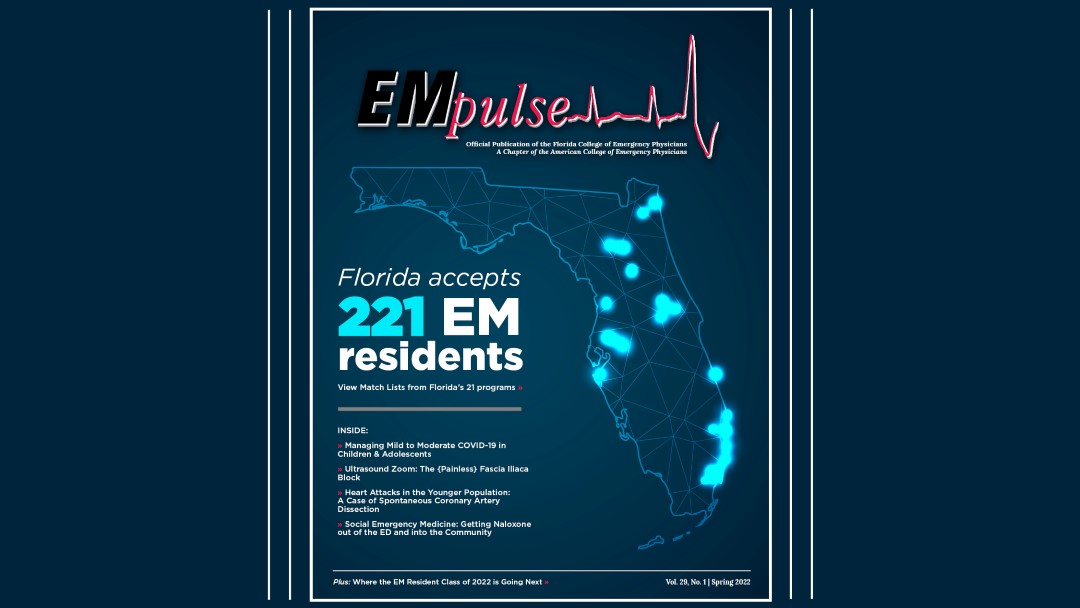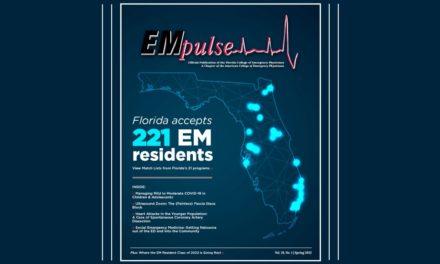Patient Misconceptions about Buprenorphine Induction for Opioid Use Disorder in the Emergency Department
The Emergency Department (ED) can serve as an access point for patients to initiate medication for opioid use disorder (MOUD) with buprenorphine. Expanding ED MOUD programs increases retention in opioid use disorder (OUD) addiction services and decreases overdose deaths. [1] ED MOUD programs improve the quality of care for patients presenting to the ED with OUD-related complications through the integration of warm hand-off linkages to downstream care (e.g. direct referral with pre-established access to a community substance use disorder treatment facility). [2] Below, we dispel and counter frequent patient misconceptions about buprenorphine induction that we have encountered. These barriers to buprenorphine induction are based on over 1,500 unique patient encounters since September 2018 through our coordinated regional harm reduction continuum at the University of South Florida, which includes 700 patients enrolled in the Building Integrated Recovery for Drug Users into Emergency Medicine (BRIDGE) Program, a syringe services program at IDEA Tampa, and a low-barrier buprenorphine downstream treatment site (USF OBOT). We also offer important clinical clarifications on the buprenorphine induction process.
Patient Misconception #1: “I’m allergic to buprenorphine.”
It is common for patients to assume that they are allergic to buprenorphine, though a true allergy is rare. It is more likely that the patient received buprenorphine-naloxone (Suboxone) while they still had opioids in their system, which precipitated withdrawal. Precipitated withdrawal leaves patients physically uncomfortable and has been linked to increased rates of relapse, treatment dropout, and can act as a deterrent to future treatment. Buprenorphine without naloxone (Subutex) can be used in induction of patients convinced of an allergy that is likely prior precipitated withdrawal. Of note, buprenorphine should also be used for pregnant women instead of buprenorphine-naloxone. If precipitated withdrawal does occur, paradoxically, more buprenorphine-naloxone can be given (up to 32 mg buprenorphine). Adjuvant symptomatic treatment can include ondansetron, ibuprofen, and clonidine as needed. Our pathway is available here.
Patient Resolution: Explain to patients when to properly induce buprenorphine.
Successful buprenorphine induction is dependent upon the absence of opioids in a patient’s system at time of induction. We avoid use of buprenorphine in patients that have taken methadone in the last 72 hours (long acting) or other opioids in the last 12 hours (oxycodone, heroin, hydromorphone, morphine). Commonly used urine drug screens are not helpful since fentanyl does not lead to a positive drug test. Patient self-report, combined with a validated scoring tool such as the Clinical Opioid Withdrawal Scale (COWS), is a more reliable and useful tool for measuring withdrawal severity. To avoid precipitating withdrawal, we do not induce patients with a COWS of <5. Explaining this induction process to patients can help them understand their historical reaction to buprenorphine and allay fears of having an allergic reaction to the medication.
Patient Misconception #2: “I heard that you have to be in really bad withdrawal to take buprenorphine.”
Patients often relay to us that they “heard” that they must be in severe withdrawal (COWS >8) to begin buprenorphine. However, buprenorphine induction can occur with even mild withdrawal symptoms (COWS 4-8). The earlier a patient can be induced in the withdrawal process, the easier it is to avoid more severe symptoms.
Patient Resolution: Utilize COWS to inform the buprenorphine induction process.
Waiting until a patient is experiencing moderate to severe withdrawal symptoms before buprenorphine induction can result in unnecessary discomfort. Patients with mild symptoms (e.g., sweating, runny nose, goosebumps, shaking, nausea), are appropriate for induction (COWS >= 4). A quick conversation with the patient about the induction process, as well as how utilizing COWS to inform the induction process will actually help avoid severe withdrawal, can increase patient comfort and resolve this misconception.
Patient Misconception #3: “I have to be ready to stop using in order to start MOUD”
Patients often believe that they must be ready to cease opioid use ‘cold turkey’ in order to begin MOUD. This misconception is commonly encountered in patients that present to the ED for a chief complaint not directly associated with OUD. However, opioid withdrawal is a high-risk period associated with elevated mortality after discharge, and it is beneficial to stabilize withdrawal symptoms that present during the ED encounter.
Patient Resolution #3: Provide MOUD for patients with non-OUD related chief complaints.
Initiating buprenorphine in the ED has been associated with increased rates of linkage to outpatient treatment.3 Patients presenting to the ED for non-OUD related concerns may begin to experience acute withdrawal during the encounter and could benefit from buprenorphine induction (which may also decrease AMA, LWOT scenarios). If COWS >= 4, consider a stabilizing dose of buprenorphine-naloxone in the ED (we often start at 8mg – 2mg but a lower 4mg – 2mg dose can be tried first if needed).
Patient Misconception #4: “I don’t want to just trade one drug for another.”
Due to the social stigma surrounding MOUD, it is common to hear patients say things like, “if I wanted to keep taking drugs, I would just stay on heroin.” Abstinence-based treatment programs they have previously experienced frame MOUD as replacing one drug for another, rather than ‘doing the work’ to get clean.
Patient Resolution #4: Explain how MOUD are considered best practice.
MOUD (including buprenorphine-naloxone [Suboxone], extended release naltrexone [Vivitrol], and methadone) are considered best practice, evidence-based, front line treatments for OUD. Buprenorphine, in particular, as a partial agonist binds to opioid receptors of the brain to block withdrawal symptoms, but also has a ceiling effect which mitigates the euphoria felt with medications like methadone. The naloxone component also ensures the medication is taken as intended and is ineffectual if administered in ways other than indicated. A conversation with the patient that reframes MOUD is helpful. For example, many of us legally purchase coffee or an energy drink each day or take blood pressure medication or an allergy pill each morning. With these substances, we don’t risk infectious disease, stigma or arrest, but instead utilize those drugs in a safe way that provides happiness, better health and wellness. MOUD provides the same function for those that have opioid use disorder.
Clinical Clarifications: DATA 2000 Waiver
Historically, addiction treatment has been separated from the traditional medical and psychiatric fields and has been reliant on specialized doctors and facilities, such as those with opioid treatment programs (OTP). Though approval of the Drug Addiction Treatment Act (DATA) in 2000 sought to change this paradigm and create an avenue for primary care physicians to be formally certified (x-waivered) to treat patients for OUD outside of OTP settings, barriers to treatment expansion remain. [4] Only 23,000 physicians in the U.S. possess an x-waiver, leaving many areas of the country, particularly rural areas, without access to a single x-waivered buprenorphine prescriber. There is now a pathway for non-waivered physicians to prescribe buprenorphine in the ED by following a few simple steps and notifying the DEA of their intent to prescribe. [5]
However, the presence of the x-waiver certification contributes to OUD stigma and creates a sense that prescribing buprenorphine to treat OUD is somehow “riskier” than a provider prescribing opioids, including buprenorphine for pain. [6,7] Legislation for removal of the x-waiver requirement is a resolution that should continue to be supported by ACEP. ACEP has worked with the DEA, SAMHSA, and HHS to “X the x-waiver” and helped implement the new intent to prescribe in-lieu of traditional x-waiver policy. Telemedicine via videoconference, with an x-waiver physician, is an identified evidence-based strategy to mitigate this treatment gap both in the ED and in downstream care. This strategy, along with ECHO models (a provider expert available for other physicians) has proven successful, particularly in remote areas far from OBOT MOUD programs and areas without adequate public transit infrastructure. [7] BRIDGE incorporates a hybrid approach offering buprenorphine induction not only within the ED, but at office-based location within proximity to areas with high opioid use, as well as via telehealth at IDEA Tampa, a mobile syringe exchange program, reflecting the evolving role of the ED as a healthcare coordination hub in the 21st century. ■
References
- D’Onofrio 2015 Herring AA, Vosooghi AA, Luftig J, et al. High-Dose Buprenorphine Induction in the Emergency Department for Treatment of Opioid Use Disorder. JAMA Netw Open. 2021;4(7):e2117128. doi:10.1001/jamanetworkopen.2021.17128
- Adams, K.K., Machnicz, M. & Sobieraj, D.M. Initiating buprenorphine to treat opioid use disorder without prerequisite withdrawal: a systematic review. Addict Sci Clin Pract 16, 36 (2021). doi.org/10.1186/s13722-021-00244-8
- Woodruff, A. E., M. Tomanovich, L. Beletsky, E. Salisbury-Afshar, S. Wakeman, and A. Ostrovsky. 2019. Dismantling Buprenorphine Policy Can Provide More Comprehensive Addiction Treatment. NAM Perspectives. Commentary, National Academy of Medicine, Washington, DC. doi.org/10.31478/201909a
- Emergency Quality Network. “How to Apply for Buprenorphine Waiver Notification of Intent (NOI).” ACEP.
- Huhn, A. S., and K. E. Dunn. 2017. Why aren’t physicians prescribing more buprenorphine? Journal of Substance Abuse Treatment 78:1–7. doi.org/10.1016/j.jsat.2017.04.005
- Weintraub, E; Senevirante, Anane, J.; et al. Mobile Telemedicine for Buprenorphine Treatment in Rural Popuilations with Opioid Use.
This article is part of the following sections:








